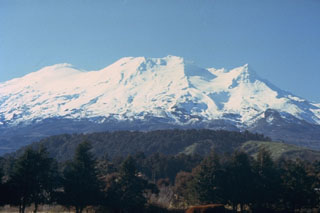Report on Ruapehu (New Zealand) — 15 June-21 June 2022
Smithsonian Institution / US Geological Survey
Weekly Volcanic Activity Report, 15 June-21 June 2022
Managing Editor: Sally Sennert.
Please cite this report as:
Global Volcanism Program, 2022. Report on Ruapehu (New Zealand) (Sennert, S, ed.). Weekly Volcanic Activity Report, 15 June-21 June 2022. Smithsonian Institution and US Geological Survey.
Ruapehu
New Zealand
39.28°S, 175.57°E; summit elev. 2797 m
All times are local (unless otherwise noted)
On 20 June GeoNet reported continuing unrest at Ruapehu. Tremor levels had been characterized as weak to moderate for the previous three weeks but increased for a brief period. Levels increased sharply during the evening of 17 June, fluctuated between moderate and strong levels on 18 June, and then decreased to weak levels by 19 June. Lake water temperatures continued to decline, reaching 22 degrees Celsius. The Volcanic Alert Level remained at 2 (on a scale from 0-5) and the Aviation Color Code remained at Yellow.
Geological Summary. Ruapehu, one of New Zealand's most active volcanoes, is a complex stratovolcano constructed during at least four cone-building episodes dating back to about 200,000 years ago. The dominantly andesitic 110 km3 volcanic massif is elongated in a NNE-SSW direction and surrounded by another 100 km3 ring plain of volcaniclastic debris, including the NW-flank Murimoto debris-avalanche deposit. A series of subplinian eruptions took place between about 22,600 and 10,000 years ago, but pyroclastic flows have been infrequent. The broad summait area and flank contain at least six vents active during the Holocene. Frequent mild-to-moderate explosive eruptions have been recorded from the Te Wai a-Moe (Crater Lake) vent, and tephra characteristics suggest that the crater lake may have formed as recently as 3,000 years ago. Lahars resulting from phreatic eruptions at the summit crater lake are a hazard to a ski area on the upper flanks and lower river valleys.
Source: GeoNet

